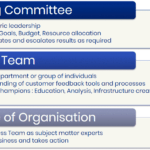There’s an old saying:
Weighing a pig doesn’t make it fatter.
If you want to improve your Net Promoter Score you need more than a great NPS measurement process. You need to do something with the data.
Having spent more than 20 years working with a range of companies in Net Promoter Score, customer feedback and business improvement processes, there are the 7 steps I’ve seen successful organisations use to improve their NPS year after year.
- 1. Listen to the Right People at the Right Time
- 2. Close The Loop with Respondents
- 3. Understand Which Factors Affect Net Promoter Score
- 4. Focus On The Few Important NPS Factors
- 5. Create KPIs For The Drivers of NPS not NPS Itself
- 6. Relentlessly Focus on Root Cause Analysis and Implement Fixes
- 7. Link NPS to Business value
1. Listen to the Right People at the Right Time
(HT Adam Dorrell and Ian Richards for pointing out the importance of this area)
Whether you choose a Transactional or Relationship NPS survey (or best of all both) you need to make certain you’re surveying the right people at the right time.
Listen to and act on feedback from outlier customers and you may make changes that detract from your most valuable customers.
This is not a trivial task. Think carefully who you will invite to respond and resist the urge to invite everyone for whom you have an email address. Be deliberate.
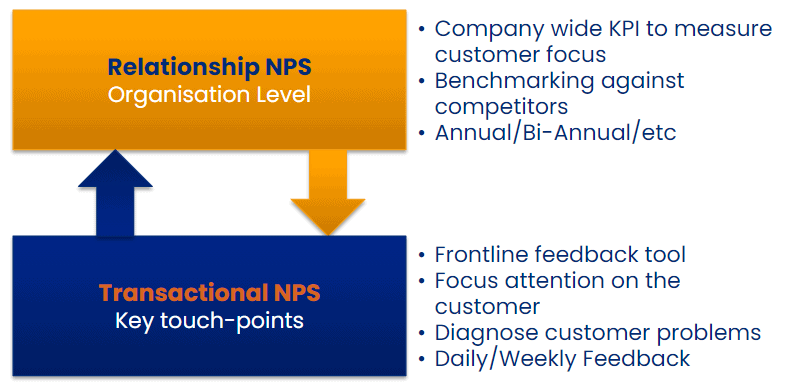
Voice By Value
It’s a simple fact that some customers are worth more to your business than others. Sometimes that value is in current business and sometimes that value is in future opportunities.
Either way, listen more closely and more often to the customers higher value customers so you can better align your business to their needs.
This is particularly important when it comes to B2B customer relationships with the added complexity of buying roles and the differing impact each role has on purchase and re-purchase decisions.
In B2B relationships you must factor in customer revenue/profit/etc AND buying role when targeting respondents and analysing data.
Listen in a Timely Manner
This comes in two parts:
Do listen to customers on a regular basis: Often enough that you can catch and react to changes in their perception or fix those mistakes that occur in every business but not so often they can’t see any change.
Don’t listen to customers who don’t have recent experience: While it’s nice that you have a customer list dating back five years, don’t invite them to give you feedback if they have been ex-customers for four years. Respondents need to have recent (you need to decide what recent means) experience with you to provide accurate feedback.
2. Close The Loop with Respondents
This easy win generates immediate improvements in NPS and customer satisfaction.
Often called Service Recovery, closing the loop with all, or at least low scoring respondents, generates three business wins:
It Solves Customer Problems Quickly
While this is a one-by-one process, it does resolve this customer’s problem and forestalls calls to your contact centre, senior management, or worse, external regulatory agency.
It Converts Detractors to Promoters
By being quick to respond and, where possible, resolve customer issues you will often turn people around from singing your shortfalls to singing your praises.
Here’s the proof: CustomerGauge compared the scores of NPS survey respondents year on year and found organisations that close the loop convert 3x more Detractors to Promoters than those that don’t. Plus you halve the number of Detractors.
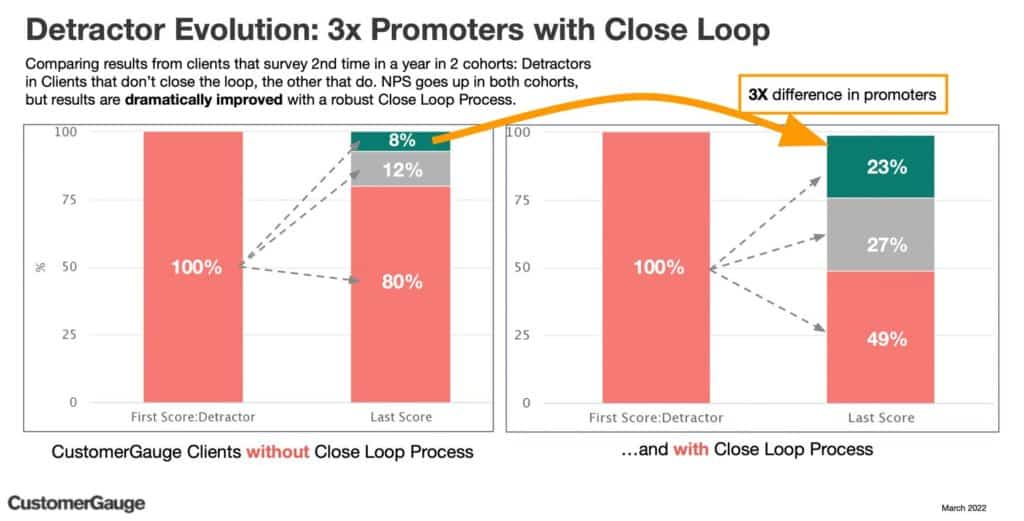
You Gather Information on How to Improve your Score
By listening closely to customers with a negative experience you will often uncover the root cause of wider, more systemic problems in the business.
See this full Service Recovery Guide for information on the best ways to design and build your Closing the Loop process.
3. Understand Which Factors Affect Net Promoter Score
To improve NPS you must understand which factors affect your Net Promoter Score. These factors will be different for every business but a best practice survey enables customers to tell you the factors that are affecting your score.
This perfect NPS survey is not difficult to design or execute but it does have some very specific features:
The Would Recommend Question
The NPS question itself:

How can We Improve?
A way to understand what is working/not working for the customer.
This can be a text response question that asks what you are doing well or poorly, attribute check boxes or attribute rating scale

Analysis of these pieces of information (score and attribute information) together will provide insights into which factors affect NPS for your specific business and touchpoint.
4. Focus On The Few Important NPS Factors
It can be tempting in the data analysis process to generate a long list of factors on which to focus to improve NPS but this is a mistake for two reasons:
- For the very large majority of businesses there are only 3-5 areas that drive most of your NPS improvement.
- It is very difficult to focus on improving more than ~3 areas of any business at the same time.
So, instead of looking for a long list of factors, try to uncover those 3-5 areas that are most important and focus on improving them.
Then regularly (6 monthly) go back and review your analysis to make sure the factors have not changed.
Quick change is unlikely but the factors do change over time with changes in the market and as you implement improvements.
5. Create KPIs For The Drivers of NPS not NPS Itself
Counterintuitively, to improve NPS quickly, don’t set NPS as a KPI. Instead, use your NPS factor analysis to set KPIs for the important NPS factors.
This works for two reasons:
It Clarifies and Focuses Staff Action
It’s much easier for staff to focus on and improve a direct metric, say, First Call Resolution or Responsiveness, than an indirect metric like NPS.
Asking staff to improve NPS, just leads to the question: but how do I do that?
Make it explicit, and easy, for staff by telling them how to improve NPS by creating KPIs for the factors.
This case study shows how Zip Water used this approach to lift their NPS from 5 to 73.
KPIs Drive the Behaviour not the Score
If, instead, you create KPI’s on NPS itself, you run the risk of introducing “score begging” into the data collection process.
This where staff actively ask customers for a good score during their interaction.
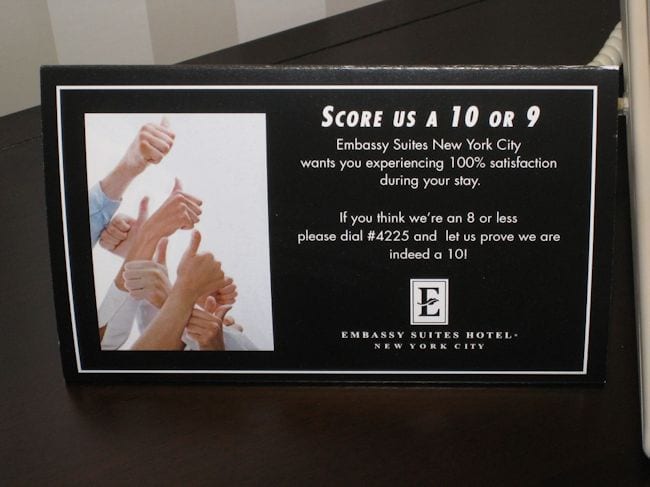
This destroys the integrity of the data collected – you don’t know what is a “real” 10 and what is a 5 turned into a 10 by pleading.
If you must have an NPS KPI, make it survey Response Rate.
Using Response Rate as a KPI reinforces to staff that the most important feature of the survey process is hearing what customers think. It makes it clear that you care more about getting the information needed to improve, than hitting an arbitrary NPS KPI.
6. Relentlessly Focus on Root Cause Analysis and Implement Fixes
Improving NPS is not a project that runs for a few weeks and then stops.
Companies that drive long term improvement in Net Promoter Score view every response from a Root Cause perspective.
For every piece of negative feedback they look to not just solve the immediate issue, but find the root cause and fix that as well. Fixing root causes prevents future problems.
This may seem like a slow process because you’re addressing lots of small issues but improving 1% a day makes you 37x better in just one year. Small changes add up quickly.
To be successful, the root cause analysis and correction process needs to be done by people intimately familiar with the process or problem. This sort of work typically can’t be done by head office, management or consultants. They are not familiar with the intimate details of the business process and systems.
Toyota gives production line staff enormous power to make changes in their famous Toyota Production System. This is because production line staff are the best informed about how things actually work (as opposed to how they are supposed to work.)
You can do this in your business with simple tools like 5 Whys Analysis.
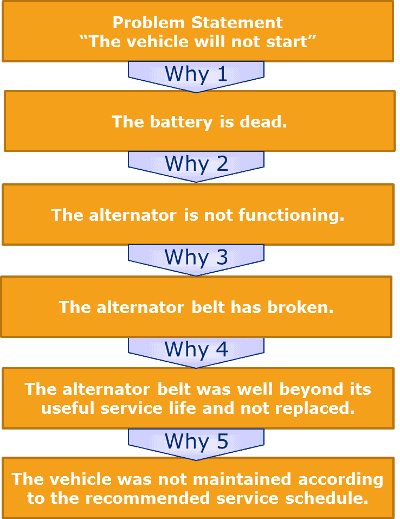
This case study shows how one company operationalised the 5 Whys process with small, simple meetings of engaged staff: Turning NPS Into Business Improvement Initiatives
7. Link NPS to Business value
Your Root Cause process will throw up lots of easy wins: change the wording on a website, update a term or condition, make a small change in a process.
However, sometimes it identifies a big payoff with a big, expensive, implementation investment. One that requires a business case and senior management, or even Board, sign-off.
If you can’t demonstrate the value the change will add to the business (revenue, cost) in return for that investment, you’ll be up against the CFO and it’s unlikely to be approved.
So, as soon as you are able, start linking NPS data to business value so you can add it to your business case.
There are many ways to do this, for example:
- Compare the revenue of Promoters and Detractors and put a revenue value on each Detractor converted.
- Compare retention rates of Promoters and Detractors and use a return on customer retention model to estimate the increased revenue from converting Detractors to Promoters.
- Compare revenue for different regions or business units with their respective NPS to estimate the lift in business revenue for improving a region.
You may need to be creative in your data analysis but it typically doesn’t need much more than an Excel spreadsheet and some time to create a solid business value calculation.
If you do this right you might find, like this company did, that the CFO is your greatest NPS advocate.
Get the Business Leader's Guide to Net Promoter Score Download Here




